Fahlman B.D. Materials Chemistry
Подождите немного. Документ загружается.


Figure 5.65. Optical absorption of undoped polyacetylene (curve 1). Curves 2 and 3 show the absorption
of polyacetylene with increasing dopant concentrations. A midgap state (arrow at 0.7 eV) emerges upon
doping, becoming more intense with further doping levels, at the expense of other peaks. Results adapted
from Roth, S. One-Dimensional Metals, Weinheim VCH, 1995.
Figure 5.66. Doping mechanisms and related applications. Reproduced from Heeger, A. J. Semiconducting
and Metallic Polymers: The Fourth Generation of Polymeric Materials, Nobel Lecture, Dec. 8, 2000.
428 5 Polymeric Materials
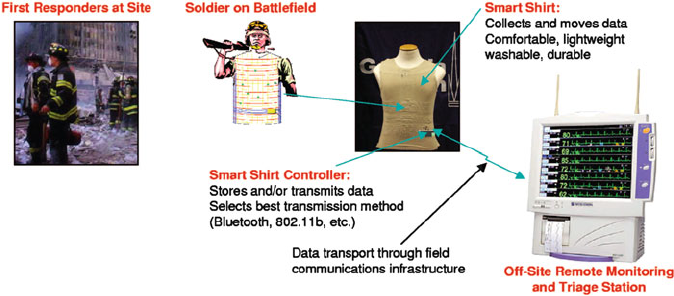
magnet was discovered at Bell Laboratories.
[103]
Miller and coworkers greatly
progressed the field of molecular magnetism in the mid-1980s.
[104]
In contrast to inor ganic compounds that require high temperature sintering
processes, organic magnets are synthesized at low temperatures using traditional
synthetic techniques. The benefits of organic-based magnets relative to inorganic
analogues are their lightweight architecture, tunable conductivity (insulating –
semiconductive), tunable solubility, and biocompatibility. With virtually every
electronic device employing magnets (e.g., automobiles, computers, audio speakers,
televisions, telephones, radios, etc.), there will be an increasing market for applica-
tions that employ these materials. In particular, the small size of individual mole-
cules relative to inorganic lattices creates the possibility of much greater storage
densities for magnetic storage applications (e.g., computer hard drives) – perhaps as
high as 200,000 Gb in
2
, which is ca. three times greater than current alloy thin film
materials.
[105]
In comparison to inorganic magnets in which electrons reside in d- and/or
f-orbitals, organic magnets contain unpaired electrons in p-orbitals. One example
of an organic magnet is 4-nitrophenylnitronyl nitroxide (XXIII), with a T
c
of 0.6 K.
In general, the critical temperatures of purely organic magnets (T
c
1.48 K) are
significantly lower than those that contain metal ions. Hence, for an observable
magnetic response at a higher T
c
, the p-electron spins are most often coupled with
unpaired d-electrons on metal ion(s). The first organometallic (containing both a
metal and ligand, with M–C bonds) magnets exploited ligands with conjugated
p-systems, capable of metal-like electrical conductivity. To date, the most commonly
used ligand systems are reduced forms of TCNQ (7,7,8-tetracyano-p-quinodimethane)
and TCNE (tetracyanoethylene) (Figure 5.68). Interestingly, if [TCNQ]
•
is replaced
Figure 5.67. Illustration of a ‘smart-shirt’ application that could be designed to incorporate conductive
polymeric materials for remote sensing and monitoring applications. Reproduce with permission from
Parks, S.; Jayaraman, S. MRS Bull. 2003, 28, 585. Copyright 2003 Materials Research Society.
5.3. “Soft Materials” Applications: Structure vs. Properties 429
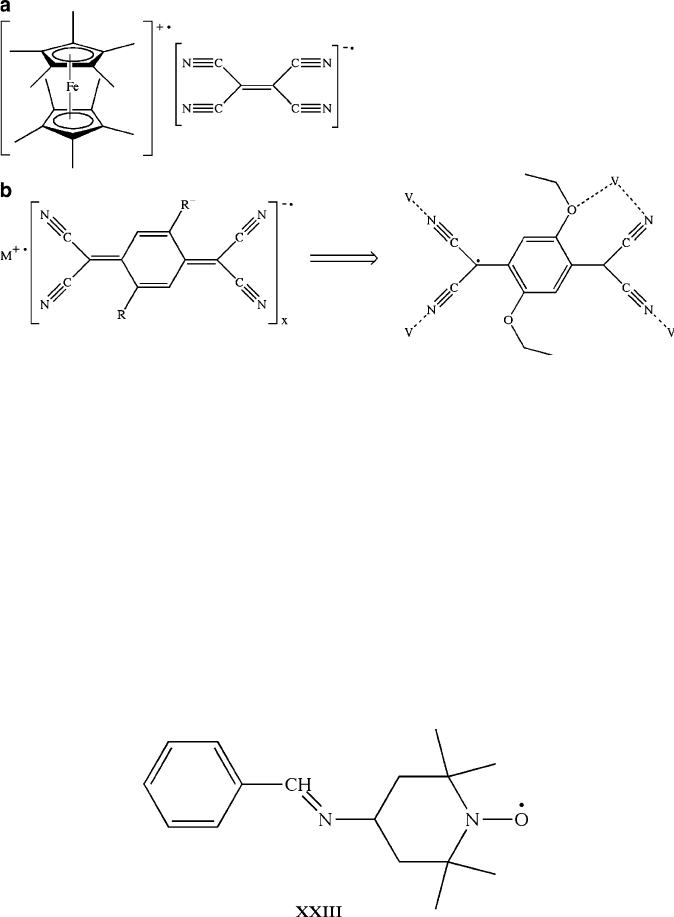
with [TCNE]
•
, one unpaired electron is delocalized over a smaller molecular struc-
ture that results in a greater spin density and magnetic response. Consequently, the
coercivity (1,000 Oe at 2 K) of [Cp
2
Fe]
•+
[TCNE]
•
is of the same magnitude as
CoPtCr (ca. 1,700 Oe), used for magnetic storage. In fact, on a mole-basis, metal
TCNE complexes are stronger ferromagnets than iron. However, the low T
c
(4.8 K)
makes this material impractical for many potential applications.
The solid-state structure of [Cp
2
Fe]
•+
[TCNE]
•
consists of alternating layers of
the cationic and anio nic species (Figure 5.69). Upon charge transfer between the
donor (cation) and acceptor (anion) within a layer, a triplet S ¼ 1 state ("" vs.
singlet "#) is formed through the transfer of a d-electro n to the p
*
-orbital on TCNE
Figure 5.68. Molecular structures of organometallic/transition metal molecular magnets. Shown are
(a) [Fe(Cp
*
)
2
]
+•
[TCNE]
•
and (b) [M
+•
][TCNQR
2
]
•
, where M–Mn, Fe, Co, Ni, and V; R–H, Br, Me,
Et,
i
Pr, OMe, OEt, and OPh. For M[TCNQ]
x
complexes (b), it was shown that the metal may bind through
the terminal N moiety of the cyano group, as well as with the oxygen from a nearby alkoxyl group if
the steric bulk is not sufficiently high (i.e., the seven-membered ring will not form with –OPh groups).
This chelate formation results in greater stability, which enhances the magnetic coupling and increases
the T
c
.
[106]
430 5 Polymeric Materials
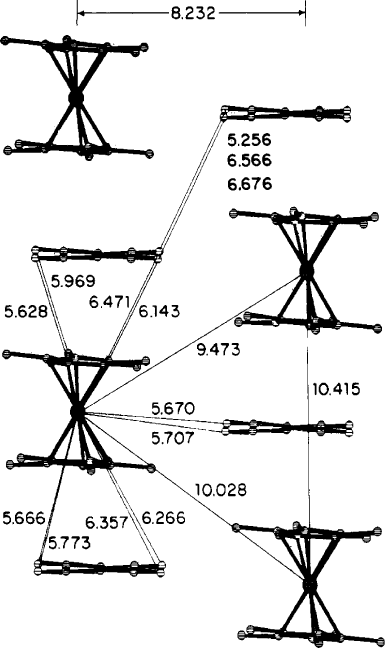
(Figure 5.70). Such intrachain spin alignment serves to stabilize the [Cp
2
Fe]
•+
[TCNE]
•
repeat units; however, for bulk macroscopic ferromagnetism, there also
has to be interchain spin alignment. This does occur at T < T
c
, since the distances
between [TCNE]
•
species and both inter- and intrachain Fe
3+
ions are roughly
equivalent.
The mixture of TCNE and hexacarbonyl vanadium(0) in an organic solvent yields
an organic-based magnet with the highest critical temperature to date – ca. 400 K
(Eq. 9). However, the detailed solid-state structure of this compound has not been
determined due to its air/water reactivity, amorphous morphology, and solvent
insolubility. The entrapped solvent is at least partially responsible for its air sensi-
tivity and magnetic susceptibility. That is, CVD of V[TCNE] in the absence of
Figure 5.69. Solid-state structure of [Cp
2
Fe][TCNE], showing relevant intra- and interchain distances.
Reproduced with permission from Miller, J. S.; Calabrese, J. C.; Rommelmann, H.; Chittipeddi, S. R.;
Zhang, J. H.; Reiff, W. M.; Epstein, A. J. J. Am. Chem. Soc., 1987, 109, 769. Copyright 1987 American
Chemical Society.
5.3. “Soft Materials” Applications: Structure vs. Properties 431
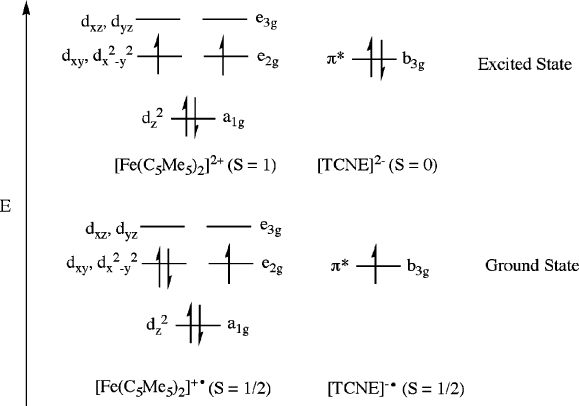
methylene chloride yields air stable films, and acetonitrile-processed V[TCNE] has
a significantly lower T
c
due to V—NC—CH
3
interactions (less effective ferromag-
netic coupling).
x TCNE + V(COÞ
6
!
methylene chloride
V[TCNE
x
yCH
2
Cl
2
+6CO
ðgÞ
ð9Þ
The observed magnitude of bulk ferromagnetic ordering depends on both the
number and 3-D arrangement of unpaired electrons throughout the entire lattice.
Since bulk spin coupling is a consequence of the overall solid-state structure, the
determination of crystal structures of molecular magnetic materials by X-ray and
neutron diffraction remains an active research area. Even at the single-molecule level,
the magnetic properties of the material may be complex, and (hopefully) tunable. For
example, the antiferromagnetism of a sterically encumbered nickel azide complex
may be switched on or off by thermally manipulating the geometry about one of
the nickel ions (Figure 5.71). Other examples of light-induced structural transforma-
tions represent another emerging area of molecular magnetic research.
[107]
Although this chapter is focused on “soft” organic-based materials, we would be
remiss if other more recent and active molecular magnetic materials were not men-
tioned. A number of materials known as single-molecule magnets have been identi-
fied, with the majority being transition metal oxo clusters that exhibit a 2-D
honeycomb-layered structure (Figure 5.72a). However, the oxo ligand exhibits multi-
ple bridging possibilities with a wide variability of the M–O–M angles, which greatly
Figure 5.70. Ground- and excited-state electronic configurations of [Fe(C
5
Me
5
)
2
] and TCNE species.
Adapted from Miller, J. S.; Calabrese, J. C.; Rommelmann, H.; Chittipeddi, S. R.; Zhang, J. H.; Reiff,
W. M.; Epstein, A. J. J. Am. Chem. Soc., 1987, 109, 769. Copyright 1987 American Chemical Society.
432 5 Polymeric Materials
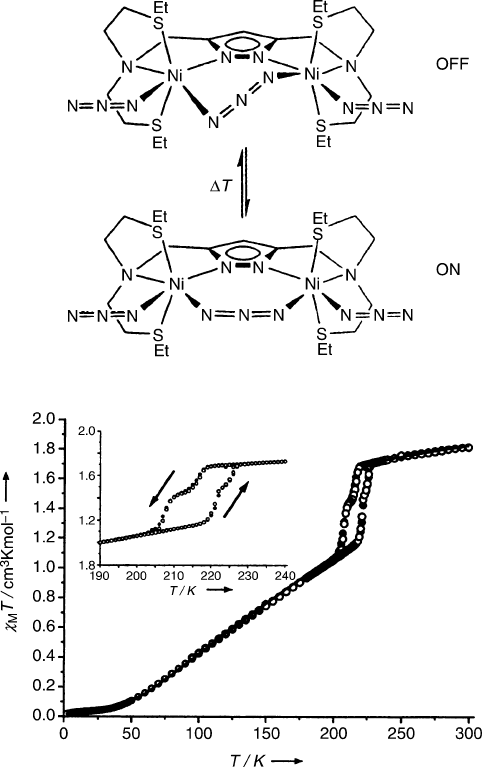
affects the M–M magnetic coupling in the solid. Consequently, more recent work has
been focused on transition metal cyano (—CN) complexes, which result in a much
greater structural control since the ligand may linearly bridge only two metal centers
(M—CN—M
0
). The most widely studied cyano complexes that exhibit either ferri- or
ferromagnetic behavior are analogues of Prussian Blue, Fe
4
III
[Fe
II
(CN)
6
]
3
·H
2
O
(Figure 5.72b).
Figure 5.71. Molecular structure (top, showing off/on states for antiferromagnetic coupling of Ni
2+
ions)
and hysteresis curve (bottom) for [LNi
2
(N
3
)
3
] – inset is a magnified view of the 200–225 K region.
Reproduced with permission from Leibeling, G.; Demeshko, S.; Dechert, S.; Meyer, F. Angew. Chem. Int.
Ed. Eng., 2005, 44, 7111. Copyright 2005 Wiley-VCH.
5.3. “Soft Materials” Applications: Structure vs. Properties 433
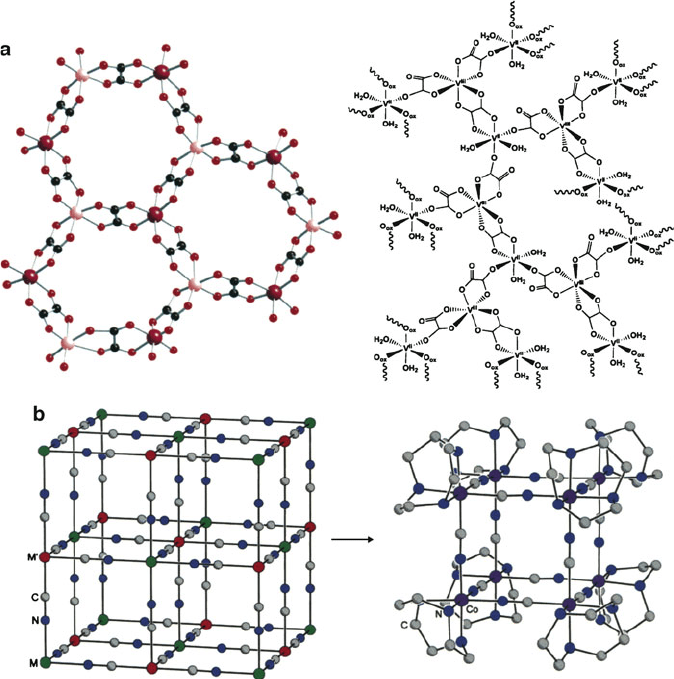
Before we delve further into these cyano-based structure s, let us review a bit of
inorganic chemistry, to understand the ligand effect on the electronic configuration
of the metal ions in a complex. As you are aware, all ligands behave as a Lewis base
toward a metal center, donating an electron pair(s) through filled s-orp-orbitals.
The cyano ligand (and others such as —CO and —C
2
H
4
, etc.) represents a special
case since it contains an unsaturated (triple) bond. Accordingly, the metal is able to
donate electron density back to the ligand into its empty p
*
-orbitals, a process known
as M ! L “back-bonding.” As you would expect, this phenomenon is most
Figure 5.72. Molecular structures of other molecular magnetic materials. Illustrated are (a) tris(oxalato)
metalates [M
II
M
III
(ox)
3
], where M
II
═Mn, Fe, Ni, Co, Cu, Zn; M
III
═Cr, Fe, Ru, and (b) the simplified
crystal structure of Prussian Blue, with an example of the analogue structure [(tacn)
8
Co
8
(CN)
12
]
12+
, where
the tacn ligand is 1,4,7-triazacyclononane. Reproduced with permission from (a) Min, K. S.; Rhinegold,
A. L.; Miller, J. S. Inorg. Chem., 2005, 44, 8433, and (b) Beltran, L. M. C.; Long, J. R. Acc. Chem. Res.,
2005, 38, 325. Copyright 2005 American Chemical Society.
434 5 Polymeric Materials

pronounced for metals in low oxidation states, where the metal ion is most apt to
reduce its buildup of negative charge. This synergistic electron donation and back-
donation delocalizes the electron density between the ligand and metal, which
greatly strengthens the M–L bond. Consequently, a comparative scale known as
the spectrochemical series has been developed to indicate whether a ligand is active
toward back-bonding with the metal. Whereas unsaturated ligands are all considered
“strong-field”, halides and othe r s-donors are all weak-field ligands since they do
not have available empty orbi tals to accept electron density from the metal.
A number of factors such as identity/oxidation state of the metal and structure/
charge of the ligand(s) will determine the electronic configuration of the metal
center in a transition metal complex. For an octahedral complex, the d-orbitals of
the transition metal are not degenerate, but are split based on their relative interac-
tions with the ligands. For a metal with 3 d-electrons, there is no ambiguity with
regard to its electroni c configuration. However, for d
4
and higher, the fourth electron
may be placed either in the lower or higher orbital groups (Figure 5.73). In particu-
lar, complexes containing 4d/5d metals, low oxidation-state metals (preferring
M ! L back-bonding), and strong-field ligands will dictate a strong-field (low-
spin) configuration. Depending on whether the complex adopts a low-spin or high-
spin configuration, the number of unpaired electrons will vary significantly. For
example, consider a d
4
complex: low-spin has two unpaired electrons (S ¼ 1),
whereas high-spin has four unpaired electrons (S ¼ 2).
[108]
As a terminal ligand, the —CN group always results in a low-spin complex.
However, when bridging two metals each end will exhibit different ligand field
strengths. That is, the C- end (M CN—M) will yield a low-spin configuration for
M, but the N-end (M—CN ! M
0
) will yield a high-spin configuration for M
0
.
Hence, for Prussian Blue, which has the ! Fe
II
CN ! Fe
III
NC ! Fe
II
bonding motif, the d
6
Fe
II
sites will be low-spin (S ¼ 0), whe reas the d
5
Fe
III
sites
will be high-spin (S ¼ 5/2). This means that ferromagnetic ordering may only occur
through distant Fe
III
—Fe
III
sites, which occurs at a relatively low T
c
(5.6 K). In order
to improve the orderin g distances with the Prussian Blue array, there has been much
interest in replacing Fe with other transition metals (especially early transition
metals in low oxidation states). Hence, the Prussian Blue structure allows for a
Figure 5.73. Comparative electronic configurations of low-spin (strong-field) and high-spin (weak-field)
d
4
metal ions (e.g., Mn
3+
,Cr
2+
,V
+
).
5.3. “Soft Materials” Applications: Structure vs. Properties 435
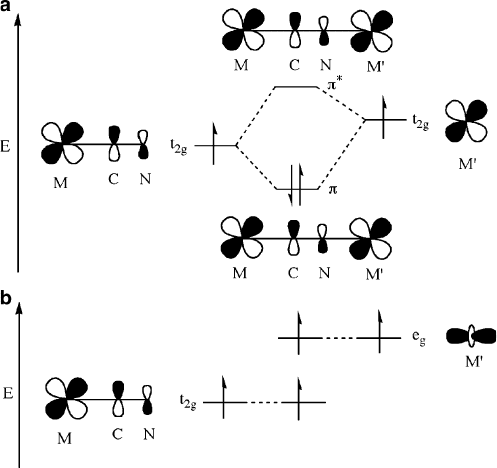
highly tunable magnetic susceptibility, since a variety of metal ions may be used in
association with the cyano ligand. Not only will this affect the number of unpaired
electrons that are coupled throughout the lattice, but also the type of ordering (e.g.,
ferro-, ferri-, antiferromagnetic) based on the metal d-orbital s that house the
unpaired electrons. In particular, ferromagnetic ordering occurs when the electrons
in the metal ions reside in orthogonal orbi tals (e.g., M(t
2g
)/M
0
(e
g
)). By contrast,
antiferromagnetic coupling occurs when the electrons are housed in orbitals of
comparable symmetry (e.g., M(t
2g
)/M
0
(t
2g
)), as illustrated in Figure 5.74.
For optical storage applications, it is desirable to have a material that alters its
magnetic properties in response to light. This effect is exhibited by Prussian Blue
itself, wherein some low-spin Fe sites are converted to a high-spin configuration.
More recently, this behavior has been demonstrated for mixed-metal systems such as
K
0.4
Co
1.3
[Fe(CN)
6
]·5H
2
O.
[109]
The light-induced redox reaction may be described
by Eq. 10, where diamagnetic Fe
II
becomes paramagnetic and may couple with other
unpaired electrons throughout the solid.
[110]
Fe
II
CN ! Co
III
!
hn
Fe
III
CN ! Co
II
ð10Þ
Figure 5.74. Simplified molecular orbital diagrams for an M—CN—M
0
unit with octahedrally
coordinated metal centers. Shown are (a) antiferromagnetic coupling from overlap of symmetrically
aligned orbitals and (b) ferromagnetic ordering from overlap of orthogonal orbitals. Adapted with
permission from Beltran, L. M. C.; Long, J. R. Acc. Chem. Res., 2005, 38, 325. Copyright 2005
American Chemical Society.
436 5 Polymeric Materials
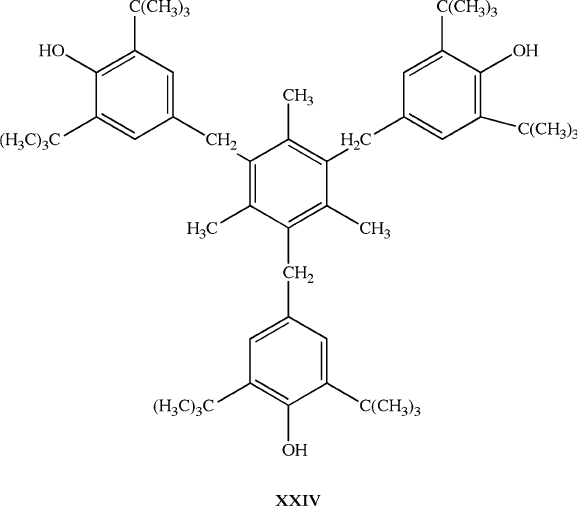
5.4. POLYMER ADDITIVES
Although the properties of polymers may be fine-tuned based on the functional
groups that are present in their repeat units, all commodity polymers also contain a
number of components in order to impart desired properties. Some common additives
include:
(i) Stabilizers (antioxidants:
[111]
e.g., 1,3,5-trimethyl-2,4,6-tris(3,5-di-tert-butyl-4-
hydroxybenzyl) benzene, XXIV; UV-stabilizers: e.g., TiO
2
; heat-stabilizers:
[112]
e.g., tetrabutyltin, tetraoctyltin). Used to protect the polymer from oxidation,
UV light, and heat during/after processing.
(ii) Nucleating/clarifying agents (e.g., nucleation: sodium benzoate-based, nucle-
ation/clarifying: sorbitol-based). Used to increase the crystallization rate of
semi-crystalline polymers such as polypropylene, polyamide, and polyester.
Clarifying agents reduce haze and significantly increase polymer transparency.
(iii) Curatives (chain extenders and crosslinkers: e.g., 3,5-diethyltoluene-2,4-diamine,
XXV;
[113]
cure promoters: e.g., N-(2-hydroxyethyl)-N-methyl-para-toluidine,
XXVI;
[114]
polymerization inhibitors: e.g., tris(N-nitroso-N-phenylhydro-
xylamine) aluminum salt, XXVII
[115]
). Used to promote polymer curing at lower
temperatures for urethanes, epoxies, polyesters, vinyl esters, acrylates, and ureas.
Also used for free radical scavenging and metal chelation to prevent unwanted
polymerization during the manufacture and storage of olefinic-type resins.
5.4. Polymer Additives 437
